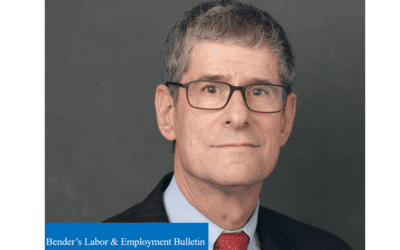The Employee Retirement Income Security Act permits aggrieved individuals whose employee benefit claims have been denied to bring a civil action to recover benefits claimed to be due.[1]
The Federal Rules of Civil Procedure explicitly state there is only one form of action, the civil action, and that the rules apply to all civil actions brought in federal court.[2]
Nevertheless, ERISA civil procedure differs from other types of federal civil actions in unique ways. I have previously written extensively on the subject,[3] but until recently no federal courts have addressed the issue of why ERISA cases deviate from the normal civil procedure utilized in other federal civil cases. In the past few months, though, such a discussion has begun.
A concurring opinion on Nov. 2, in Card v. Principal Life Insurance Co.[4] written by U.S. Circuit Judge Eric Murphy of the U.S. Court of Appeals for the Sixth Circuit is the first to question the basis for remands of ERISA cases, one of the anomalies that distinguish ERISA cases from other civil actions. Card involved a claim for disability benefits brought by a nurse who suffered from chronic lymphocytic leukemia.
Her employer’s group disability insurer, Principal Life, denied her benefit claim and the district court upheld the finding, rejecting the plaintiff’s argument that the benefit denial was arbitrary and capricious. The court of appeals reversed that decision though, and ordered Principal Life to reconsider its findings.
Following the issuance of the initial appellate ruling, Card’s attorney filed a motion seeking an award of attorney fees and also requested that the case be reopened because Principal Life failed to act on the remand within 45 days. The district court refused to entertain the plaintiff’s motions though, and issued an order finding it had no jurisdiction to do so because the court of appeals had remanded the case directly to Principal Life.
Card’s attorney promptly filed a notice of appeal from that order. Although the defendant argued the lack of jurisdiction finding was unreviewable, the court of appeals disagreed.
The court conceded that it may have created confusion in its prior ruling by remanding directly to Principal Life rather than to the district court with instructions to remand to Principal Life, but the court ruled the district court nonetheless retained jurisdiction during the remand proceeding and thereafter.
While that ruling resolved the thorny procedural issue presented, it did not end the discussion because Judge Murphy wrote a concurring opinion, which began with two critical questions:
Why do courts have any power to “remand” a pending federal lawsuit to one of the private litigants? That strikes me as quite an unusual thing. Why shouldn’t the district courts instead oversee any additional litigation compelled by an arbitrary-and-capricious finding using the normal rules of civil procedure?
Judge Murphy pointed out that while every federal court of appeals has assumed that a remand power exists in ERISA cases, the U.S. Supreme Court has never spoken on the issue. The opinion acknowledged that remands are ubiquitous in federal procedure but are generally based on statutory authority or, in the case of appellate review of federal executive branch administrative agency decisions, under separation-of-powers principles.
However, Judge Murphy’s research did not uncover any other area of law in which a federal court remands a case to a private litigant. The concurrence further noted the ERISA statute says nothing about remands and that the Supreme Court has made it clear that courts are not to read additional remedies or requirements into the ERISA statute that are not explicitly enumerated in the text of the law.[5]
Judge Murphy then examined remands in trust law disputes since that area of the law is the basis for much of ERISA’s statutory scheme.[6] While courts hearing disputes between beneficiaries of trusts and trustees have traditionally invoked the courts’ power to order trustees to revisit decisions found to have been an abuse of the trustees’ discretion, such orders resemble injunctions.
However, no court has articulated that theory in ERISA litigation, which is why the majority of federal circuit courts have held that remand orders by district courts are not final orders and are therefore unappealable.[7]
Since he was unable to find any statutory source or other basis for ERISA remands, Judge Murphy concluded that the practice whereby courts remand ERISA cases “seem[s] to rest on paper-thin reasoning” and pointed out that courts have “largely assumed its existence without addressing the subject in detail.”
The concurrence noted another recent opinion from another Sixth Circuit judge, Amul Thapar, who questioned the validity of mandatory administrative exhaustion in ERISA cases, writing, “it is troubling to have no better reason for a rule of law than that the courts made it up for policy reasons.”[8]
The concurrence in Card then concluded:
In short, I tend to think that the existing caselaw has not adequately justified what seems to me to be a strange procedure — remanding a case to a private litigant for further proceedings rather than completing those proceedings in the court. And if plan administrators ultimately cannot ground this procedure in ERISA’s text as interpreted against its historical context, I find it difficult to believe that the Supreme Court would sanction it. Because it is well established in this circuit, though, I concur in the majority opinion explaining how it should be implemented.
Judge Murphy’s concurrence, coupled with Judge Thapar’s concurring opinion questioning the requirement of administrative exhaustion prior to filing suit on an ERISA claim, has opened a long-overdue dialogue on a number of questionable practices used by courts in ERISA litigation that deviate from the Federal Rules of Civil Procedure and have never been addressed by the Supreme Court.
In addition to administrative exhaustion and remands, here are a few other issues that deserve thoughtful reexamination because the justification for such rules is as paper-thin as the ones that Judges Thapar and Murphy have recently questioned:
- Why are jury trials disallowed in ERISA denial-of-benefits cases?[9]
- Why do most courts except for the U.S. Court of Appeals for the Seventh Circuit[10] refuse to even hold trials in ERISA cases and deem such matters record review proceedings?
- What basis do courts have for deviating from normal summary judgment rules in ERISA cases?[11]
- Why is discovery more limited in ERISA cases than in other federal civil actions?[12]
- What does substantial evidence mean in the context of deferential review of ERISA claim decisions?[13]
Now that courts have begun to question key aspects of ERISA civil procedure, expect to see future cases on these issues and perhaps even a Supreme Court review encompassing the entire regime of ERISA litigation.
Mark D. DeBofsky is a shareholder at DeBofsky Law.
This article was first published by Law 360 on November 16, 2021.
[1] 29 U.S.C. § 1132(a)(1)(B).
[2] Federal Rules of Civil Procedure 1 and 2.
[3] Mark D. DeBofsky, A Critical Appraisal of the Current State of ERISA Civil Procedure, 18 Emp. Rts. & Emp. Pol’y J. 203, 233–34 (2014) (cited in concurring opinion).
[4] Card v. Principal Life Ins. Co. , 2021 U.S. App. LEXIS 32599, 2021 WL 5074692 (6th Cir. November 2, 2021).
[5] Citing Great-West Life & Annuity Ins. Co. v. Knudson , 534 U.S. 204, 209, 122 S.Ct. 708, 151 L.Ed.2d 635 (2002) (quoting Mass. Mut. Life Ins. Co. v. Russell , 473 U.S. 134, 147, 105 S.Ct. 3085, 87 L.Ed.2d 96 (1985)).
[6] Citing Firestone Tire & Rubber Co. v. Bruch , 489 U.S. 101 (1989) (additional citations
omitted).
[7] Citing Bowers v. Sheet Metal Workers’ Nat’l Pension Fund , 365 F.3d 535, 537 (6th Cir. 2004).
[8] Wallace v. Oakwood Healthcare, Inc. , 954 F.3d 879, 900 (6th Cir. 2020) (Thapar, J., concurring); see, DeBofsky, “6th Circ. Ruling Offers Fresh Look at ERISA Exhaustion,” Law 360 (April 24, 2020); available at https://www.law360.com/articles/1264985.
[9] The Sixth Circuit has also led the way in opening a dialogue on the jury trial issue. See, DeBofsky, “Benefits Ruling Raises Jury Trial Question for ERISA Cases,” Law 360 (September 24, 2021); available at https://www.law360.com/articles/1424015.
[10] See, Krolnik v. Prudential Insur. Co. , 570 F.3d 841 (7th Cir. 2009).
[11] While Rule 56 of the Federal Rules of Civil Procedure requires the absence of any genuine issue of material fact before a court grants summary judgment, in ERISA cases, courts have disregarded that requirement. See, Gross v. Sun Life Assur. Co. of Canada , 734 F.3d 1, 16017 (1st Cir. 2013) (describing “summary judgment” as “simply a vehicle for deciding the issue”); LaAsmar v. Phelps Dodge Corp. Life, Accidental Death & Dismemberment & Dependent Life Ins. Plan , 605 F.3d 789 (10th Cir. 2010) (same).
[12] According to Federal Rule of Civil Procedure 26(b)(1) discovery is permitted relating to any nonprivileged matter “that is relevant to any party’s claim or defense and proportional to the needs of the case.” However, federal courts routinely prohibit discovery in ERISA cases. See, e.g., Perlman v. Swiss Bank Corporation , 195 F.3d 975, 981 (7th Cir. 1999) (finding error in the district court’s allowance of discovery).
[13] See, DeBofsky, “5th Circ. Opinion is Right to Question ERISA Review Norms,” Law360 (October 5, 2021); available at https://www.debofsky.com/articles/5th-circ-opinion-is-right-to-question-erisa-review-norms/.







